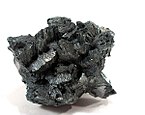Semseyite
| Semseyite | |
|---|---|
 Semseyite - Brioude-Massiac (Massif Central) France (11x3.5cm)[1] | |
| General | |
| Category | Sulfosalt mineral |
| Formula (repeating unit) | Pb9 Sb 8 S21 |
| IMA symbol | Ssy[2] |
| Strunz classification | 2.HC.10d |
| Crystal system | Monoclinic |
| Crystal class | Prismatic (2/m) (same H-M symbol) |
| Space group | C2/c |
| Unit cell | a = 13.64 Å, b = 11.96 Å c = 24.46 Å; β = 105.87°; Z = 4 |
| Identification | |
| Color | Dark gray to black |
| Crystal habit | Tabular, elongated prismatic crystals, commonly twisted; rosettelike groups |
| Cleavage | Perfect on {112} |
| Tenacity | Brittle |
| Mohs scale hardness | 2.5 |
| Luster | Metallic |
| Diaphaneity | opaque |
| Specific gravity | 6.15 |
| References | [3][4][5] |
Semseyite is a rarely occurring sulfosalt mineral and is part of the class of lead antimony sulfides. It crystallizes in the monoclinic system with the chemical composition Pb9Sb8S21. The mineral forms dark gray to black aggregates.
Etymology and history[]
Semseyite was first described for an occurrence in the Felsöbánya mine in Baia Sprie, Romania in 1881 by József Sándor Krenner (1839–1920). The mineral was named after Hungarian mineralogist (1833–1923).
Occurrence[]
Semseyite forms in hydrothermal solutions at temperatures between 300 and 350 °C.[6] It occurs in association with bournonite, jamesonite, sphalerite, zinkenite, , guettardite, jordanite, , galena, pyrite, chalcopyrite, tetrahedrite, arsenopyrite and siderite.[3]
Images[]

Semseyite from Baia Sprie, Maramures County, Romania

Cluster of semseyite crystals on massive sulfide matrix

A spray of semseyite crystals perched, freestanding, at the apex of a cluster of quartz crystals

Vug filled with clusters of sprays of lightly iridescent, metallic-lustre semseyite blades on sphalerite matrix
References[]
- ^ J.J. Périchaud : "Metal Layers of the District with Antimony of Brioude-Massiac (French Massif Central)", BRGM, 1968
- ^ Warr, L.N. (2021). "IMA–CNMNC approved mineral symbols". Mineralogical Magazine. 85 (3): 291–320. Bibcode:2021MinM...85..291W. doi:10.1180/mgm.2021.43. S2CID 235729616.
- ^ a b Handbook of Mineralogy
- ^ Mindat
- ^ Webmineral data
- ^ Andreas Kamrath: “Geology and mineralogy of ore stores Herja” Archived 2011-02-13 at the Wayback Machine
| Wikimedia Commons has media related to Semseyite. |
- Lead minerals
- Antimony minerals
- Sulfide minerals
- Monoclinic minerals
- Minerals in space group 15



